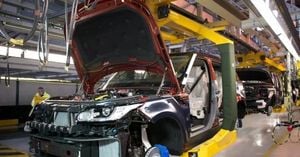On October 21, 2025, the world of artificial intelligence and cloud computing took a giant leap forward as Google Cloud and NVIDIA jointly announced the general availability of G4 virtual machines (VMs), powered by NVIDIA’s latest RTX PRO 6000 Blackwell Server Edition GPUs and AMD’s EPYC Turin CPUs. It’s a move that’s set to shake up enterprise AI, offering unprecedented performance, flexibility, and access to advanced AI infrastructure for industries ranging from manufacturing to advertising. But what does this all mean for businesses, developers, and the broader AI ecosystem?
According to GuruFocus, Google Cloud’s new G4 VMs deliver up to nine times the performance of their previous generation for demanding AI workloads. That’s not just a marginal improvement—it’s a massive leap, especially for tasks like multimodal model training, text-to-image generation, robotics, and complex data visualization. NVIDIA, for its part, highlighted that this launch completes its full Blackwell platform, tying together large-scale AI training systems like the HGX B200 with enterprise-ready RTX PRO 6000 units. The result: a seamless, end-to-end solution for both training and inference, right at the fingertips of enterprise users.
But the story doesn’t stop at raw computing power. As reported by HPCwire, these G4 VMs are more than just fast—they’re versatile. Each VM can be configured with up to eight RTX PRO 6000 GPUs, totaling a staggering 768 GB of GDDR7 memory. They natively integrate with Google Kubernetes Engine and Vertex AI, streamlining containerized deployments and making life easier for machine learning engineers. For those running large-scale analytics, integration with Apache Spark and Hadoop via Dataproc is also on the table. And for the creative and engineering crowd? The VMs support popular third-party applications like Autodesk AutoCAD, Blender, and Dassault SolidWorks, so designers and engineers can harness cloud-based power for everything from 3D modeling to advanced simulation.
Why are these advances so significant? For one, NVIDIA’s RTX PRO 6000 Blackwell GPUs are built on a cutting-edge architecture that combines fifth-generation Tensor Cores—delivering a huge leap in AI performance and supporting new data formats like FP4 for faster, more efficient computation—with fourth-generation RT Cores that more than double real-time ray-tracing performance over the previous generation. That means cinematic-quality graphics and hyper-realistic simulations are now within reach, even for remote or distributed teams.
It’s not just about hardware, though. The launch also brings NVIDIA Omniverse and Isaac Sim as ready-to-use images on the Google Cloud Marketplace. As HPCwire explains, Omniverse is a suite of integration-ready libraries and frameworks built on Universal Scene Description (OpenUSD), allowing enterprises to build and operate digital twins—real-time, virtual replicas of factories and products that can be used to optimize operations. Isaac Sim, meanwhile, is a reference application for training and validating AI-driven robots in physics-based virtual environments. Companies like WPP are already using G4 VMs with Omniverse to generate photorealistic 3D advertising environments at scale, while Altair is leveraging the platform for demanding simulation and fluid dynamics workloads.
Behind these technical achievements lies a bigger shift in how businesses approach AI. At the Google Cloud Partner AI Series event, leaders from Google Cloud and its strategic collaborators discussed a new grading system for AI projects—one that values measurable outcomes and clear governance over mere novelty. Eliot Danner, global managing director for Google Distributed Cloud at Google Cloud, summed up the new mood: "I think we went through sort of the era of experimentation and now we’re seeing the era of outcome expectation." In other words, boards and executives are no longer content with proofs of concept; they want AI investments to deliver tangible results, from increased revenue to streamlined operations.
This outcome-driven mindset is shaping the entire AI partner ecosystem. Alexis Johnson, director of customer engineering, strategic AI and ISV at Google Cloud, pointed out that the fastest-moving teams are those that combine deep product knowledge with industry-specific context—before any model even touches production. Gaurav Goel of NTT Data echoed this, describing how their partnership with Google Cloud is focused on modernizing clients’ infrastructure so it’s AI-ready from the ground up, with storage and access controls aligned from the start.
Central to this transformation is the idea that data is now a currency for business. Iliana Quinonez, director of customer engineering for North America startups at Google Cloud, urged organizations to "think about your data as a currency." Rajeev Nayar of Tiger Analytics reinforced the point: "One of the things that people are beginning to realize is good AI requires good data." Investing in robust data layers isn’t just a technical necessity—it’s a critical business strategy for scaling AI and extracting real value.
Perhaps the most visible impact of these advances is in the rise of agentic AI systems—intelligent agents that can automate repetitive, high-volume tasks while remaining compliant with complex policies. Vikas Agarwal, chief technology and innovation officer of PwC Advisory, PwC US, shared a striking example: a call center optimized from 2,000 to 1,000 seats, and a legal workflow that reduced a 200-person paralegal team to just 20 by using AI agents to translate statutes into plain English with built-in checks. "It was an even greater gain," Agarwal said, noting the transformation exceeded expectations once client confidence was established through rigorous back-testing and scoped permissions.
Of course, as AI systems become more powerful and interconnected, security becomes paramount. John Maddison, chief product and corporate marketing officer at F5 Inc., described how adversarial testing—such as through F5’s recently acquired Calypso AI—has become a standing practice. These tests simulate up to 10,000 attacks each month across multiple models, providing regular rankings and feedback to ensure resilience. Prerak Mehta of Google Cloud emphasized that the biggest threat to AI models now comes from other AI systems, requiring a security layer that spans endpoints and coordinates across entities, especially in hybrid and multicloud environments.
Ultimately, the partnership between Google Cloud and NVIDIA is about more than just technology—it’s about empowering enterprises to tackle their most complex challenges with confidence, scalability, and security. By bringing together cutting-edge hardware, robust software ecosystems, and a new focus on measurable outcomes, they’re setting the stage for a new era of AI-driven innovation. For businesses looking to stay ahead, the message is clear: the future is here, and it’s powered by collaboration, data, and relentless pursuit of results.
With these advances, the cloud isn’t just a place to store data or run applications—it’s becoming the engine room for the next wave of industrial digitalization, scientific discovery, and creative expression. And as the AI ecosystem matures, those who invest wisely in infrastructure, data, and partnerships will be the ones to watch.




